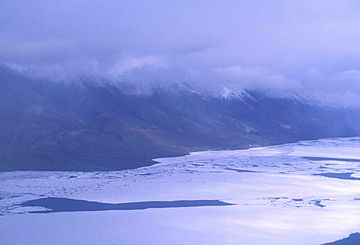Garfield Range facts for kids
Quick facts for kids Garfield Range |
|
|---|---|

Western part of Lake Hazen (Summer 1997); Quttinirpaaq National Park, Nunavut, Canada
|
|
| Geography | |
| Country | Canada |
| State/Province | Nunavut |
| Range coordinates | 81°48′07″N 72°39′40″W / 81.80194°N 72.66111°W |
| Parent range | Arctic Cordillera |
The Garfield Range is a group of mountains located on Ellesmere Island in Nunavut, Canada. These mountains are among the most northern in the world, found far up in the Arctic. They are a part of the larger Arctic Cordillera mountain system.
Contents
Exploring the Garfield Range
The Garfield Range is a fascinating place with unique features shaped by ice and time. It's a great example of the rugged beauty found in Canada's far north.
Where is the Garfield Range?
The Garfield Range sits right next to Lake Hazen. This lake is very special because it's the largest lake north of the Arctic Circle when you measure its volume. The mountains act like a natural wall between Lake Hazen and a huge ice cap called the Grant Land ice cap.
To the east, the mountain range stretches across a flat area known as the Hazen Plateau. To the west, it almost reaches the very end of Tanquary Fiord.
What are the Mountains Like?
The mountains in the Garfield Range are made of very old rocks. These rocks formed a long, long time ago during the Paleozoic era. The peaks rise to heights between about 1,067 meters (3,500 feet) and 1,433 meters (4,700 feet).
Deep valleys cut through the mountains. These valleys are where major rivers flow. The rivers get their water from the huge ice fields and glaciers that cover parts of the range.
The mountains can tower as much as 1,500 meters (about 4,900 feet) above Lake Hazen. Typically, the slopes facing south are steep and don't have much snow. However, the slopes facing north are gentler and are usually covered in snow and ice.
Ice and Water in the Range
The Garfield Range is home to impressive glaciers. For example, the Gilman Glacier is one of the largest glaciers that drains into Lake Hazen.
Broad valleys, about 5 to 8 kilometers (3 to 5 miles) wide, cut across the range. Sometimes, these valleys are filled with long tongues of ice from glaciers. One amazing example is the Henrieta Nesmith Glacier. This huge glacier descends to within about 4 kilometers (2.5 miles) of Lake Hazen near its northwestern end.

